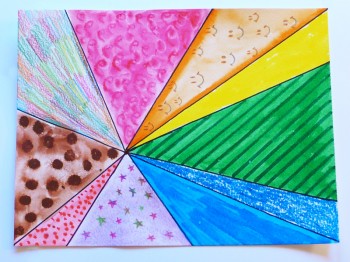Line - the path of a point.
Line is a form with width and length, but no depth. Line is characterized by length and direction(s). Artists use lines to create edges, the outlines of objects. Lines are also used to create perspective, and dominant directional lines are often adopted to create a sense of continuance in a composition. Line can be very simple, suggesting only abstraction, or it can suggest form even through simplicity.
Line as Value
Lines or crosshatching can also be used to create areas of grey inside a drawing. These areas of darker shading inside a figure, called areas of value, can give a more three-dimensional feeling to an object.

Color
Color occurs when light in different wavelengths strikes our eyes. Objects have no color of their own, only the ability to reflect a certain wavelength of light back to our eyes. As you know, color can vary in differing circumstances. For example, grass can appear gray in the morning or evening or bright green at noon. Colors appear different depending on whether you view them under incandescent, florescent or natural sunlight. Colors also change according to their surroundings. You can see this by looking at the color squares below - the reddish outline box is the same color in all the examples.

Texture
Texture is the surface quality of an object. We experience texture when we touch objects and feel their roughness, smoothness or patterns. Texture is the artist's way of mapping these tactile impressions on to the two-dimensional picture. Texture is created by varying the pattern of light and dark areas on an object. Notice how the areas of light and dark give the impression of depth to the image below.
Texture is the surface quality of an object in a tactile sense. Texture is captured in a two-dimensional plane by varying the pattern of light and dark areas on an object. Textures are described by word such as rough, silky, or pebbly.
Texture is the surface quality of an object in a tactile sense. Texture is captured in a two-dimensional plane by varying the pattern of light and dark areas on an object. Textures are described by word such as rough, silky, or pebbly.

Shape
A shape is an enclosed object. Shapes can be created by line, or by color and value changes which define their edges.
shapes can be created by enclosing line, or by color and value changes which define edges. Form and shape can be described as either organic or geometric.
shapes can be created by enclosing line, or by color and value changes which define edges. Form and shape can be described as either organic or geometric.
- Organic forms are typically irregular in outline, and often asymmetrical. Organic forms are most often thought of as naturally occurring.
- Geometric forms are those which correspond to named regular shapes, such as squares, rectangles, circles, cubes, spheres, cones, and other regular forms. Architecture is usually composed of geometric forms. These forms are most often thought of as constructed or made.


1) Organic shapes.
2) Geometric forms in 3-dimensional architecture (Frank Lloyd Wright).
 The appearance of line in a three-dimenionsal form: a wire sculpture (Alexander Calder, Joan Mir�, c. 1930. )
The appearance of line in a three-dimenionsal form: a wire sculpture (Alexander Calder, Joan Mir�, c. 1930. )  Line is not just an artificial tool of the artist.
Line is not just an artificial tool of the artist.  Lines that are grouped together often create a sense of value, density or texture.
Lines that are grouped together often create a sense of value, density or texture. Form
Form is a shape that is three-dimensional.


No comments:
Post a Comment